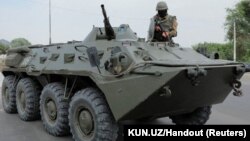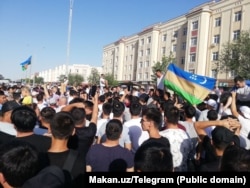ALMATY, Kazakhstan -- Uzbekistan used force "unjustifiably" during fatal unrest in its autonomous Karakalpakstan region, Human Rights Watch (HRW) says in a report that demands accountability for the July crackdown.
Citing independent medical analysis of video and photo evidence, the report is the first by a major rights organization since more than 20 people were killed amid protests over proposed changes to the Uzbek Constitution that would have undermined the region's special status.
HRW concludes that despite documented incidents of violence by protesters, the unprecedented demonstrations in the region of 2 million people were "largely peaceful" -- an assessment that contrasts starkly with an official narrative of "riots" backed by "external forces."
The crisis in Karakalpakstan began with the publication in June of a draft constitution that would have shorn the sprawling autonomous republic of its right to hold a vote on secession from Uzbekistan, quickly evolving into the biggest challenge thus far for President Shavkat Mirziyoev, who has credited his six years in office with ushering in a "new Uzbekistan."
Mindful of comparisons with the bloody massacre of hundreds of protesters in the Ferghana Valley city of Andijon in 2005 -- an event that permanently stained the long authoritarian reign of Mirziyoev's predecessor, Islam Karimov -- the authorities walked back all the amendments affecting Karakalpakstan in the wake of the violence.
Tashkent also appointed a commission, largely consisting of government officials and headed by state human rights ombudswoman Feruza Eshmatova, to investigate the protests that saw more than 200 people injured and hundreds arrested.
But HRW cast doubt over the commission's purpose, noting in its report that it was "unrealistic to expect the commission to present genuinely independent findings, especially with respect to the actions of police and security forces."
No date for the hitherto planned referendum on the constitutional changes has been set, despite the period for public discussion of the draft -- twice extended in the wake of the crisis -- ending on August 1.
With Tashkent's reform drive faltering in recent years, HRW Director Hugh Williamson said the government's response to the demonstrations "is a test of whether Uzbekistan has turned a page and truly intends to respect human rights and rule of law" in a statement issued with the group's report.
"It should not shy away from bringing to account security force personnel responsible for the deaths and injuries of so many people," Williamson added.
Deadly Stun-Grenade Usage
With the Internet in Karakalpakstan restricted during the July 1-2 protests and effectively severed for the next two weeks, there are still many unanswered questions about how unrest there escalated to result in 21 deaths, including four security officers, according to an official toll.
But the findings of HRW's report undermine the authorities' contention that the response was proportional, condemning "inappropriate use of small arms and various types of grenades, weapons that can cause severe injuries and death when used recklessly."
Grenades are a key focus of the report.
In 10 instances where verified videos and images appeared to show protesters either dead or at risk of death, HRW identified seven as showing damage to their bodies from explosives.
Analyzing one manifestation of explosive trauma filmed some 60 kilometers northwest of Karakalpakstan's administrative center, Nukus, and posted to Telegram in early July, Rohini Haar, an emergency physician consulted by HRW, gave a pessimistic opinion of the victim's chances to survive.
"There is a bone out, a huge cavity, bleeding, spinal cord damage, and that is just on the face of it," the report quoted Haar as saying. "He is alive in the video and the doctor is trying to find all the bleeding vessels and clamp them off. But I can see he is bleeding out; it is not clear if he will survive this. If he does, he will not walk again."
Beyond the human damage rendered by the explosives, the HRW report also points to the circumstances in which force was used, pointing out that "in none of the scenes identified by Human Rights Watch where grenades or small arms ammunition were used did it appear that the lives of security force personnel or of others were under threat."
In one video recorded in Nukus, where the protests were the largest, a member of the security forces "throws a concussion grenade toward a group of protesters who are carrying a man who appears to have a severely damaged right foot. The grenade detonates next to the protesters, forcing them to drop the wounded man and flee."
The Uzbek Interior Ministry released a video in July purporting to show the anti-riot weaponry used by security forces during the protests and stressing its nonlethal nature in the video's voiceover.
HRW identified the use of Israeli-manufactured gear but also stressed the apparent use of "significantly heavier projected grenades...that can cause significant injury or death."
HRW said that "at least one protester" may have been killed by grenades manufactured by Arsenal AD of Bulgaria, which weigh between five and 10 times more than standard stun grenades and were not shown in the ministry's video.
The Bulgarian company did not respond to a request for comment, the group said.
A Path Forward?
Karakalpakstan takes its name from the Karakalpak minority, whose language is very similar to Kazakh and which has official status inside the republic.
The ethnic group does not form a majority of the region's overall population, but is predominant in Nukus, where more than 300,000 people live and where the protests began. The western region makes up nearly 40 percent of Uzbekistan's total area but only about 5 percent of the country's 36 million people.
Although Karakalpakstan has been formally entitled to hold a referendum on secession for nearly three decades -- a concession secured in the early years of Uzbekistan's post-Soviet independence -- this prospect never seemed likely.
One major obstacle would be Tashkent's general attitude toward competitive elections, since the country has never staged a vote deemed free or fair by international monitors. Indeed, it was the undynamic nature of Uzbekistan's political system, rather than any urgency regarding Karakalpakstan's status, that appeared to prompt the constitutional reform drive.
Speaking in June, Senate deputy speaker Sadyk Safaev said that the very fact of adopting a new constitution would be enough to "reset" Mirziyoev's term count and allow him to run for a third consecutive term -- an argument that was also used to prolong Karimov's reign before his death in 2016 after 27 years in power.
A return to a seven-year rather than the five-year presidential terms was another perceived advantage for the incumbent.
Tashkent has all but admitted that the proposals affecting Karakalpakstan were made in error. Mirziyoev dismissed his chief of staff, Zainilobiddin Nizomiddinov, just days after the crisis, and publicly reprimanded lawmakers from Karakalpakstan's legislature for what he said was their failure to communicate.
Yet it is Karakalpakstan residents that participated in the protests who have been punished the most. The ombudswoman's office on November 1 reported that 35 residents had recently been released from prison, bringing the total to more than 100 set free, with unknown numbers still jailed.
The ombudswoman's special commission has released a stream of footage showing tearful admissions of guilt from former detainees and even more emotional reunions with their family members.
More than a dozen people have also been charged with anti-constitutional crimes and face potentially lengthy spells in prison.
There is "limited transparency about the scope of [the Eshmatova] commission's work and its mandate, and the intended outcome of the investigation," HRW noted. The group said it was not even clear if the commission would produce a report.
The United States, the European Union, and the United Kingdom have all called for a fair investigation into events.
In an interview with Voice of America in July, Uzbek Ambassador to the United States Javlon Vakhabov said Tashkent was "talking with leading human rights organizations and hearing their concerns and advice."
While Tashkent has claimed foreign involvement in the protests, no official has yet articulated how this alleged involvement took place or by whom.
Last month, HRW raised alarm about the detention of four Karakalpak diaspora members in neighboring Kazakhstan -- two of whom were women -- seemingly in response to requests from Tashkent.
The four activists detained in mid-September and early October have all applied for asylum in Kazakhstan and would be protected from immediate deportation to Uzbekistan under Kazakh law if officials in Astana agree to review their cases, a lawyer told HRW.
The rights group called on Kazakh authorities not to deport them to Uzbekistan, where they "face a serious risk of politically motivated prosecution and torture."













